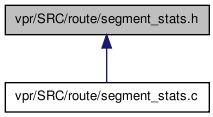vpr/SRC/route/segment_stats.h File Reference
 This graph shows which files directly or indirectly include this file:
This graph shows which files directly or indirectly include this file:Go to the source code of this file.
Functions | |
| void | get_segment_usage_stats (int num_segment, t_segment_inf *segment_inf) |
Function Documentation
| void get_segment_usage_stats | ( | int | num_segment, |
| t_segment_inf * | segment_inf | ||
| ) |
Computes statistics on the fractional utilization of segments by type (index) and by length. This routine needs a valid rr_graph, and a completed routing. Note that segments cut off by the end of the array are counted as full-length segments (e.g. length 4 even if the last 2 units of wire were chopped off by the chip edge).
Definition at line 24 of file segment_stats.c.
{
int inode, length, seg_type, max_segment_length, cost_index;
int *seg_occ_by_length, *seg_cap_by_length; /* [0..max_segment_length] */
int *seg_occ_by_type, *seg_cap_by_type; /* [0..num_segment-1] */
float utilization;
max_segment_length = 0;
for(seg_type = 0; seg_type < num_segment; seg_type++)
{
if(segment_inf[seg_type].longline == FALSE)
max_segment_length = max(max_segment_length,
segment_inf[seg_type].length);
}
seg_occ_by_length = (int *)my_calloc((max_segment_length + 1),
sizeof(int));
seg_cap_by_length = (int *)my_calloc((max_segment_length + 1),
sizeof(int));
seg_occ_by_type = (int *)my_calloc(num_segment, sizeof(int));
seg_cap_by_type = (int *)my_calloc(num_segment, sizeof(int));
for(inode = 0; inode < num_rr_nodes; inode++)
{
if(rr_node[inode].type == CHANX || rr_node[inode].type == CHANY)
{
cost_index = rr_node[inode].cost_index;
seg_type = rr_indexed_data[cost_index].seg_index;
if(!segment_inf[seg_type].longline)
length = segment_inf[seg_type].length;
else
length = LONGLINE;
seg_occ_by_length[length] += rr_node[inode].occ;
seg_cap_by_length[length] += rr_node[inode].capacity;
seg_occ_by_type[seg_type] += rr_node[inode].occ;
seg_cap_by_type[seg_type] += rr_node[inode].capacity;
}
}
printf("\nSegment usage by type (index):\n");
printf("Segment type Fractional utilization\n");
printf("------------ ----------------------\n");
for(seg_type = 0; seg_type < num_segment; seg_type++)
{
if(seg_cap_by_type[seg_type] != 0)
{
utilization = (float)seg_occ_by_type[seg_type] /
(float)seg_cap_by_type[seg_type];
printf("%8d %5.3g\n", seg_type,
utilization);
}
}
printf("\nSegment usage by length:\n");
printf("Segment length Fractional utilization\n");
printf("-------------- ----------------------\n");
for(length = 1; length <= max_segment_length; length++)
{
if(seg_cap_by_length[length] != 0)
{
utilization = (float)seg_occ_by_length[length] /
(float)seg_cap_by_length[length];
printf("%9d %5.3g\n", length,
utilization);
}
}
if(seg_cap_by_length[LONGLINE] != 0)
{
utilization = (float)seg_occ_by_length[LONGLINE] /
(float)seg_cap_by_length[LONGLINE];
printf(" longline %5.3g\n", utilization);
}
free(seg_occ_by_length);
free(seg_cap_by_length);
free(seg_occ_by_type);
free(seg_cap_by_type);
}
 Here is the call graph for this function:
Here is the call graph for this function: Here is the caller graph for this function:
Here is the caller graph for this function:


